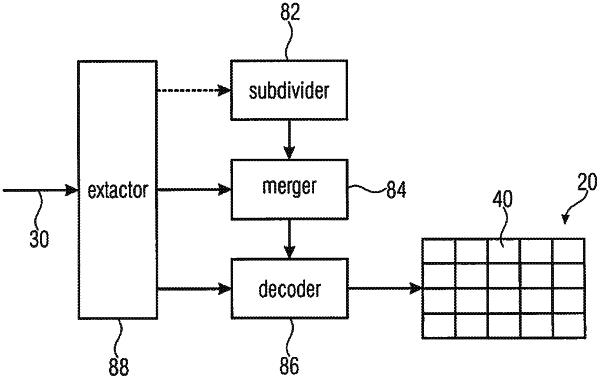| CPC H04N 19/52 (2014.11) [H04N 19/172 (2014.11); H04N 19/176 (2014.11); H04N 19/184 (2014.11); H04N 19/50 (2014.11); H04N 19/70 (2014.11)] | 16 Claims |

|
1. An apparatus having a processor and a memory for decoding a bitstream having a picture encoded therein, comprising:
a subdivider implemented on the processor and configured to subdivide the picture into sample sets of samples;
a merger implemented on the processor and configured to merge the sample sets into groups of one or more sample sets each;
a decoder implemented on the processor and configured to decode the picture using coding parameters transmitted in the bitstream in units of the groups of sample sets, wherein the decoder is configured to decode the picture by predicting the picture, decoding a prediction residual for predetermined sample sets and combining the prediction residual and a prediction resulting from predicting the picture, for the predetermined sample sets;
an extractor implemented on the processor and configured to extract the prediction residual and the coding parameters from the bitstream, along with one or more syntax elements for each of at least a subset of the sample sets, indicating as to whether the respective sample set is to be merged into one of the groups along with another sample set or not, wherein the merger is configured to perform the merging responsive to the one or more syntax elements,
wherein the extractor and the merger are configured to sequentially step through the sample sets according to a sample set scan order, and, for a current sample set, to:
extract a first binary syntax element from the bitstream using arithmetically decoding using a first context;
if the first binary syntax element assumes a first binary state, merge the current sample set into one of the groups by inferring the coding parameters for the current sample set to be equal to the coding parameter associated with this group, skip the extraction of the prediction residual for the current sample set and step to the next sample set in sample set scan order;
if the first binary syntax element assumes a second binary state, extract a second syntax element from the bitstream using arithmetically decoding using a second context different from the first context; and
depending on the second syntax element,
extract a third syntax element from the bitstream using arithmetically decoding using a third context different from the first context and the second context and merge the current sample set into one of the groups by inferring the coding parameters for the current sample set to be equal to the coding parameters associated with one of a set of predetermined candidate sample sets neighboring the respective sample set, which is signaled by the third syntax element, with extracting at least one further syntax element concerning the prediction residual for the current sample set or
perform the extraction of the coding parameters for the current sample set with extracting at least one further syntax element concerning the prediction residual for the current sample set,
wherein the prediction residual is represented by transformation coefficient levels.
|